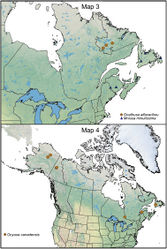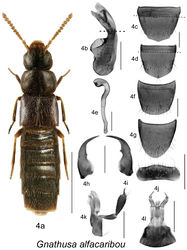Gnathusa alfacaribou
| Notice: | This page is derived from the original publication listed below, whose author(s) should always be credited. Further contributors may edit and improve the content of this page and, consequently, need to be credited as well (see page history). Any assessment of factual correctness requires a careful review of the original article as well as of subsequent contributions.
If you are uncertain whether your planned contribution is correct or not, we suggest that you use the associated discussion page instead of editing the page directly. This page should be cited as follows (rationale):
Citation formats to copy and paste
BibTeX: @article{Klimaszewski2014ZooKeys412, RIS/ Endnote: TY - JOUR Wikipedia/ Citizendium: <ref name="Klimaszewski2014ZooKeys412">{{Citation See also the citation download page at the journal. |
Ordo: Coleoptera
Familia: Staphylinidae
Genus: Gnathusa
Name
Gnathusa alfacaribou Klimaszewski & Langor – Wikispecies link – Pensoft Profile
- Gnathusa alfacaribou Klimaszewski et al. 2011[1]: 55–56.
Diagnosis
Body length 3.0–3.4 mm, sides subparallel; body colour dark brown, with tarsi lighter and antennae brown and often with reddish tinge; head round and almost as wide as pronotum or at most as wide as pronotum, equal in size to pronotum; pronotum transverse, angular, about as wide as maximum width of elytra; abdomen subparallel, at base as wide as elytra, widest in apical half; antennal articles 5–10 quadrate to slightly transverse (Fig. 4a). MALE: tergite VIII pointed apically (Fig. 4c); sternite VIII slightly pointed at apex (Fig. 4d); median lobe of aedeagus with tubus strongly produced ventrally in lateral view, apex pointed (Fig. 4b). FEMALE: tergite VIII truncate apically (Fig. 4f); sternite VIII rounded apically (Fig. 4g); spermatheca pipe-shaped, with small spherical capsule and long, thin and almost straight stem (Fig. 4e).
Distribution
This native Nearctic species is known only from Labrador (Map 3).
Bionomics
This epigaeic species was collected from June to October using pitfall and flight intercept traps in black spruce-lichen, spruce-moss and old fir forests.
Locality data
CANADA: Newfoundland: Labrador, Middle Brook, Lake Melville, Plot: MID 4, 17.VI.2005 (LFC) 1 male [holotype]; Labrador, Middle Brook, Lake Melville, Plot: MID 4, 17.VI.2005 (MUN) 1 male [paratype]; same data except: Plot: MID 3, 4.VII.2005 (MUN) 1 female [paratype], Plot: MID 4 (MUN) 1 female [paratype], Plot: MID 5, 18.VII.2005 (MUN) 1 female [paratype]; Labrador, Ossak Camp, Station 1, lichen-black spruce forest, 8.X.2004 (MUN) 1 female [paratype]; SW Labrador, 72 km E Labrador City, Rt. 500, km 93, 53°08.6 N, 66°05.9 W, 12–27.VIII.2001, S. and J. Peck, FIT, 600 m, spruce-moss forest 2001-34 (LFC) 1 female [paratype].
Taxon Treatment
- Klimaszewski, J; Webster, R; Langor, D; Bourdon, C; Hammond, H; Pohl, G; Godin, B; 2014: Review of Canadian species of the genera Gnathusa Fenyes, Mniusa Mulsant & Rey and Ocyusa Kraatz (Coleoptera, Staphylinidae, Aleocharinae) ZooKeys, 412: 9-40. doi
Other References
- ↑ Klimaszewski J, Langor D, Pelletier G, Bourdon C, Perdereau L (2011) Aleocharine beetles (Coleoptera, Staphylinidae) of the province of Newfoundland and Labrador, Canada. Pensoft Publishers, Sofia and Moscow, 314 pp.
Images
|

